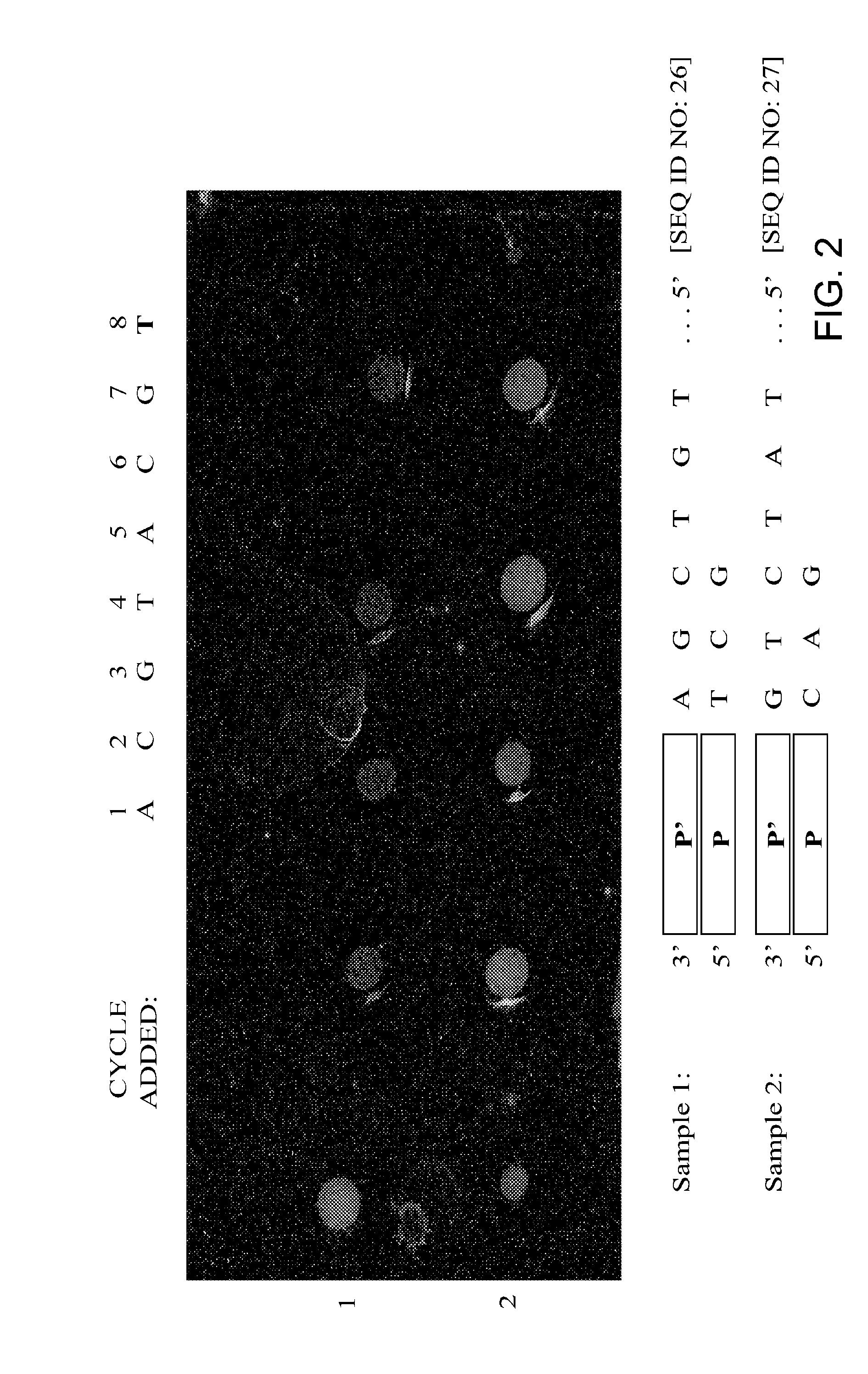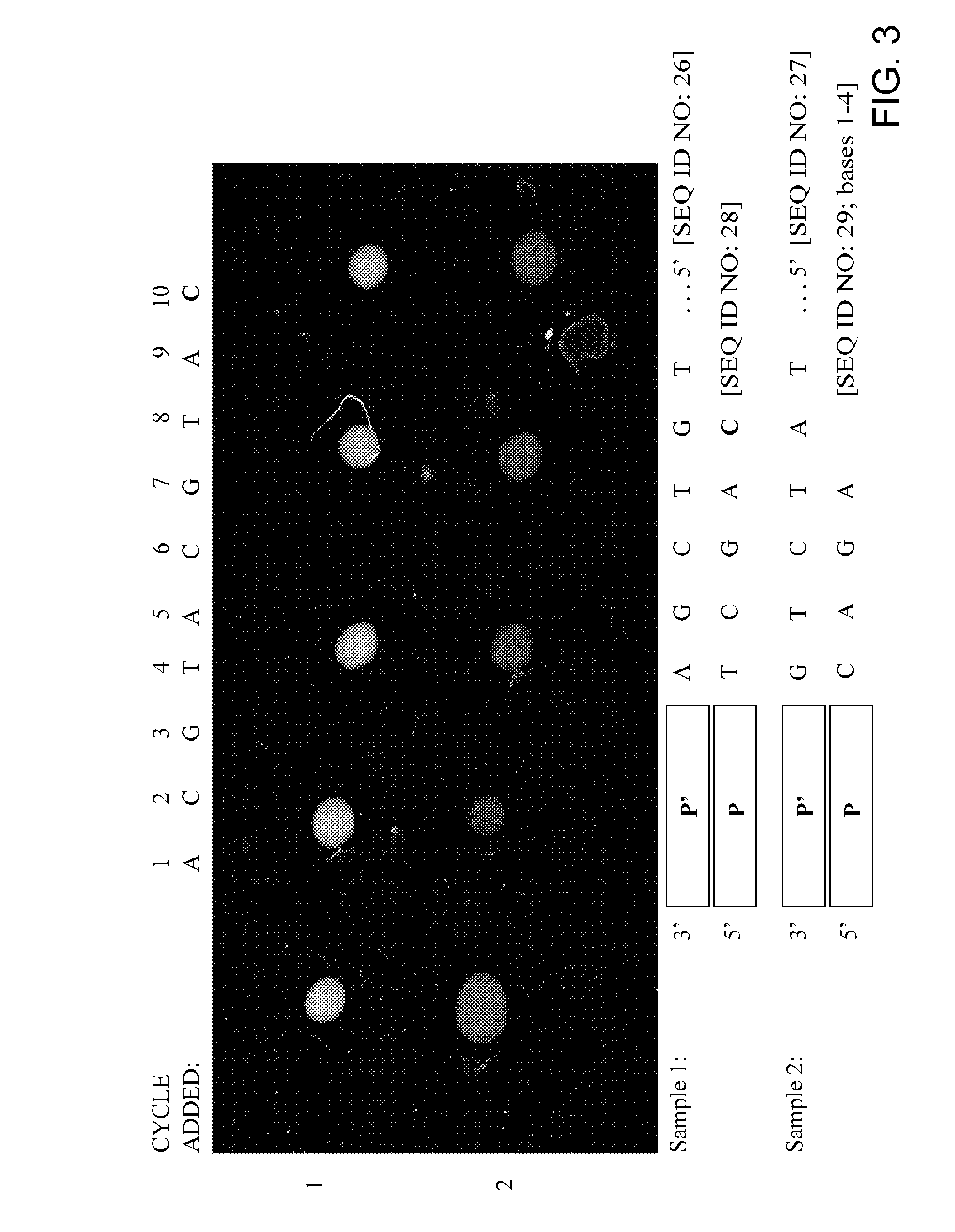Replica amplification of nucleic acid arrays
a nucleic acid array and amplification technology, applied in the field of replica amplification of nucleic acid arrays, can solve the problems of labor-intensive and costly production of arrays by conventional methods
- Summary
- Abstract
- Description
- Claims
- Application Information
AI Technical Summary
Benefits of technology
Problems solved by technology
Method used
Image
Examples
example 1
Production of a Plurality of a Nucleic Acid Array According to the Invention Step 1. Production of a Nucleic Acid Pool with which to Construct an Array According to the Invention
[0124]A pool or library of n-mers (n=20 to 9000) is made by any of several methods. The pool is either amplified (e.g. by PCR) or left unamplified. A suitable in vitro amplification “vector,” for example, flanking PCR primer sequences or an in vivo plasmid, phage or viral vector from which amplified molecules are excised prior to use, is used. If necessary, random shearing or enzymatic cleavage of large nucleic acid molecules is used to generate the pools if the nucleic acid molecules are amplified, cleavage is performed either before or after amplification. Alternatively, a nucleic acid sample is random primed, for example with tagged 3′ terminal hexamers followed by electrophoretic size-selection. The nucleic acid is selected from genomic, synthetic or cDNA sequences (Power, 1996, J. Hosp. Infect., 34:247-...
example 2
Ordered Chromosomal Arrays According to the Invention
[0178]Direct in situ single-copy (DISC)-PCR is a method that uses two primers that define unique sequences for on-slide PCR directly on metaphase chromosomes (Troyer et al., 1994a, Mammalian Genome, 5: 112-114; summarized by Troyer et al., 1997, Methods Mol. Biol., Vol. 71: PRINS and In Situ PCR Protocols, J. R. Godsen, ed., Humana Press, Inc., Totowa, N.J., pp. 71-76). It thus allows exponential accumulation of PCR product at specific sites, and so may be adapted for use according to the invention.
[0179]The DISC-PCR procedure has been used to localize sequences as short as 100-300 bp to mammalian chromosomes (Troyer et al., 1994a, supra; Troyer et al., 1994b, Cytogenet. Cell Genetics, 67(3):199-204; Troyer et al., 1995, Anim. Biotechnology, 6(1):51-58; and Xie et al., 1995, Mammalian Genome 6:39-141). It is particularly suited for physically assigning sequence tagged sites (STSs), such as microsatellites (Litt and Luty, 1989, Am....
example 3
RNA Localization Arrays
[0192]The methods described in Example 2, above, are applied with equal success to the generation of an array that provides a two-dimensional representation of the spatial distribution of the RNA molecules of a cell. This method is applied to ‘squashed’ cellular material, prepared as per the chromosomal spreads described above in Example 2; alternatively, sectioned tissue samples affixed to glass surfaces are used. Either paraffin-, plastic- or frozen (Serrano et al., 1989, Dev. Biol. 132: 410-418) sections are used in the latter case.
[0193]Tissue samples are fixed using conventional reagents; formalin, 4% paraformaldehyde in an isotonic buffer, formaldehyde (each of which confers a measure of RNAase resistance to the nucleic acid molecules of the sample) or a multi-component fixative, such as FAAG (85% ethanol, 4% formaldehyde, 5% acetic acid, 1% EM grade glutaraldehyde) is adequate for this procedure. Note that water used in the preparation of any aqueous co...
PUM
| Property | Measurement | Unit |
|---|---|---|
| Length | aaaaa | aaaaa |
| Density | aaaaa | aaaaa |
| Efficiency | aaaaa | aaaaa |
Abstract
Description
Claims
Application Information
 Login to View More
Login to View More - R&D
- Intellectual Property
- Life Sciences
- Materials
- Tech Scout
- Unparalleled Data Quality
- Higher Quality Content
- 60% Fewer Hallucinations
Browse by: Latest US Patents, China's latest patents, Technical Efficacy Thesaurus, Application Domain, Technology Topic, Popular Technical Reports.
© 2025 PatSnap. All rights reserved.Legal|Privacy policy|Modern Slavery Act Transparency Statement|Sitemap|About US| Contact US: help@patsnap.com



